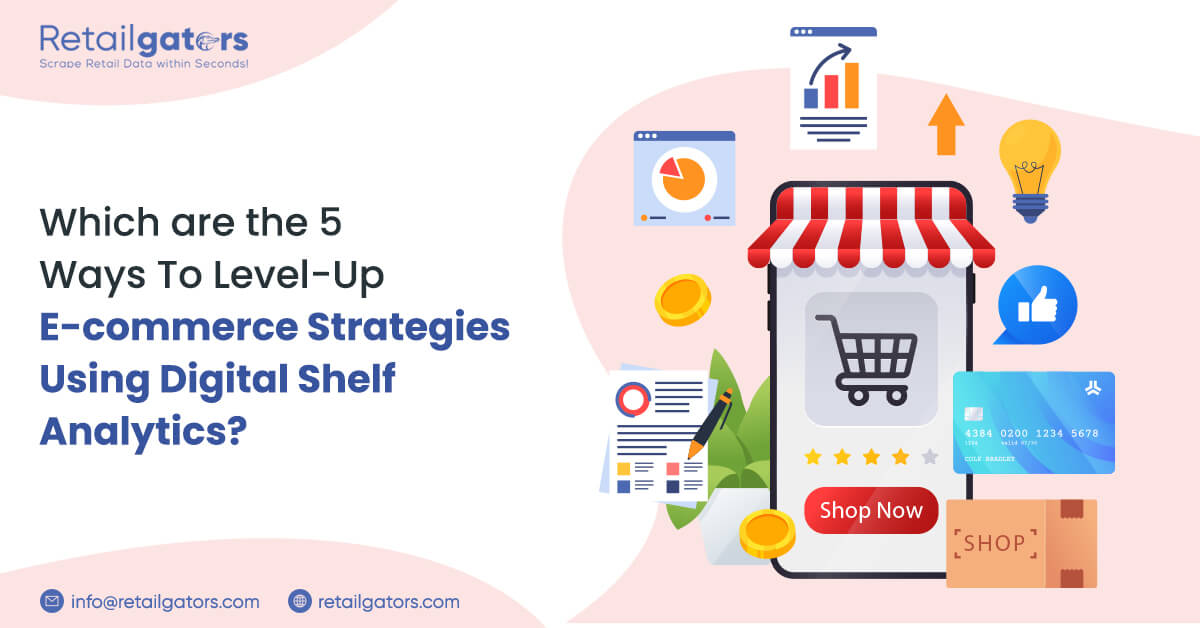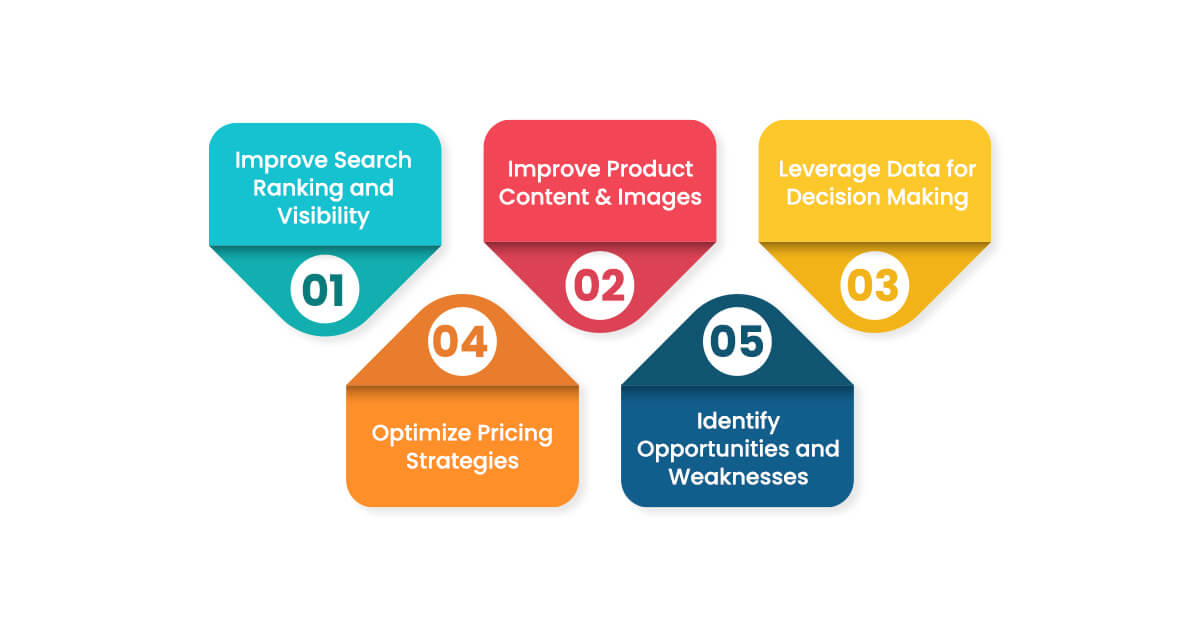
Imagine those digital shelves filled with excellent products, yet no one notices them. The fierce competition of online retail can leave even the best products buried. But fear not; Digital Shelf Analytics is your secret weapon to success. E-commerce is where success hinges on strategy, precision, and understanding customer behaviour. Ditch the guessing game and harness the power of Digital Shelf Analytics. In this blog, let us dive into five transformative ways you can refine your e-commerce strategy. It equips you with laser-sharp insights to dominate your online space. Get ready to step off the dusty digital shelf and onto the path of e-commerce success.
Role of Digital Shelf Analytics in E-commerce Strategy
When shoppers look through online stores, the digital shelf is like the stage where products show off to win the shoppers' votes. Digital Shelf Analytics helps companies understand and use a mix of complex calculations and shopper information to make informed decisions.
For businesses selling things online, knowing where their products stand and how well they're doing is super important. Digital Shelf Analytics offers a view of how their products appear on websites, how often they're seen, whether their information is correct, how well they capture shopper reviews, and how they rank in search results compared to competitors. Armed with this detailed information, businesses can:
- Change search words and group their products to fit customer interests and ways customers search.
- Make engaging and search-result-friendly names, descriptions, and images to grab attention and get people to click.
- Keep a close eye on competitors' prices and deals to ensure the prices are appealing and smart.
- Answer customer reviews and ratings quickly, helping to make their brand look better and more trustworthy.
- Identify areas where products are not performing well or opportunities they haven't yet explored. They can then address these to be seen more and sell more.
For any e-commerce strategy, digital shelf analytics is no longer optional; it is as critical. It's all about constantly getting better and finding new ways for brands to connect with their customers online.
5 Ways to Improve E-Commerce Strategies Using Digital Shelf Analytics

How do you ensure your products stand out, grab attention, and land in those virtual shopping carts? Here are five ways Digital Shelf Analytics can improve your E-commerce strategies.
Improve Search Ranking and Visibility
Making your product pages SEO-friendly can help more online shoppers see your product. Using the right and well-researched keywords in product names, descriptions, images, and metadata can boost your visibility in search results. Regularly check SEO numbers like keyword ranking, website visits from search engines, bounce rate, and time spent on a page. This will help you make needed changes and continue to get better, ensuring it's easy for customers to find your product. The easier your product is to find, the more likely you are to sell more. If you use these strategies, you can make your brand more popular online and increase search rankings.
Improve Product Content & Images
Ensure your product names grab attention and use keywords people search for. Write clear descriptions that showcase the features of your product in a way that speaks to your shoppers. Use clear, high-quality pictures from multiple angles and let customers zoom in. These pictures help customers get a better look and make them more likely to buy. Think about adding videos, 360-degree spins, or fun, clickable pictures. These can make shopping more fun and give customers a better look at what they're buying. Ensure your brand is consistent across all platforms, from your words to your pictures, to build trust and recognition. Try out different pictures or ways of describing your product to see which combination works best to get people interested and buying.
Leverage Data for Decision Making
Utilize the data to identify the products shoppers buy frequently and determine when they are most likely to make purchases. This information can help you make more informed decisions for your store. By observing shoppers' behavior on your website, you can provide a smoother and more enjoyable shopping experience. Keep track of the pricing of your products and how discounts impact sales. This can assist you in determining the optimal prices for your products. Analyze your competitors to assess how your products compare in price, appearance, and sales performance. This will help you understand your position in the market. Also, examine how your competitors attract customers through blog posts, product descriptions, or helpful videos. This can provide you with ideas for promoting your merchandise.
Optimize Pricing Strategies
Use Digital Shelf Analytics to track and compare your competitors' pricing continuously. This will help you understand where your products stand in the market and identify any pricing gaps that must be addressed. Use pricing optimization models to set the ideal price based on supply, demand, and market trends. Machine learning algorithms can help predict how pricing changes affect sales, helping you balance profitability and competitiveness. Understand the price elasticity of your products - how sensitive your customers' demand is to changes in price. This insight can help guide discounts, promotions, and regular pricing decisions to optimize profit margins. Understand how price changes affect your brand's perceived value. Continually monitor customer feedback and reviews to ensure pricing changes do not decrease perceived value or customer satisfaction.
Identify Opportunities and Weaknesses
Use Digital Shelf Analytics to check out how well your products are selling and how often people buy after viewing a product. Look at your top sellers, those not doing so well, and read your customer reviews too. This info can help you figure out how to sell more of the weaker products or put more focus on the popular ones. Keep an eye on when you run out of products and on your inventory levels. Look for patterns showing when certain products are likely to sell out or when too much stock is slowing sales. Updating your stock management strategies based on these insights ensures you have the right amount of each product. Watch for trends in the market to see what customers might want next. If you see these opportunities early, you can edge out your competitors and adjust your sales to meet changing customer tastes.
Best Practices While Using Digital Shelf Analytics
Check out the best practices that users can consider while using digital shelf analytics:
- Before data analysis, establish what you want to achieve from the insights. Your goals might change over time, but clear objectives will make interpreting and acting on the data easier.
- Regularly monitor and analyze data to stay updated with market trends, customer behavior, and competitor tactics. This helps you stay responsive and proactive.
- Use tools like predictive analytics and machine learning algorithms to gain more depth from the data, like trend predictions and customer behavior.
- Look at the big picture, not just rely on one data point. Use data from multiple channels and locations for a comprehensive view.
- Keep an eye on your competition. Keep tabs on how you measure up to others in your area and see if there's anything they're doing that you can do better.
- Customer reviews and ratings are invaluable data points that can influence product development or improvement, optimize price, and inform content strategy.
- Always validate and ensure the accuracy of your data. Errors in data collection or interpretation can lead to inaccurate insights and strategies.
- Although data is critical for developing strategies, it's equally important to maintain ethical standards and respect customer privacy.
Conclusion
Digital Shelf Analytics can improve your E-commerce business by showing you what your customers want and need and how they behave. You can adjust your plans to make sure you're giving them what they're after. By checking out your best sellers, keeping tabs on trends, watching what your customers are doing, managing your stock, and keeping an eye on other similar businesses, you're setting yourself up for success. They work best when used as parts of a whole plan. If you use all five ways together, your E-commerce business can take off exponentially. RetailGator has been a champion for years in helping businesses reach new heights by providing accurate and ready-to-use data. The world of online retail is a moving target; keep evolving, lean on helpful partners like RetailGator, and let the data guide your growth.








Leave a Reply
Your email address will not be published. Required fields are marked